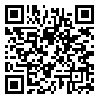1- , aammiz1@mums.ac.ir
Abstract: (324 Views)
Background and Objective: Postpartum bonding disorder is as most important of the mother–infant relationship impairment in this period. The purpose of study was to translate and validate the Postpartum Bonding Questionnaire in Iranian mothers.
Materials and methods: In this study, a descriptive, cross-sectional survey design was used. After asking for the developer’s permission; the forward-backward procedure was applied to translate the original questionnaire from English into Persian. Then following qualitative face validity, a sample of primiparous mothers completed the questionnaire and construct validity was assessed using exploratory factor analyses. Reliability was evaluated by performing internal consistency analysis (average inter-item correlation, Cronbach’s alpha, and McDonald’s omega) and construct reliability.
Results: In all, 263 primiparous mothers completed the questionnaire. Exploratory factor analysis revealed the 13-item version of the PBQ with three-factor (‘impaired bonding’, ‘rejection and anger’, and ‘anxiety about care’) structure which explained 49.19% of the overall variance observed and this confirmed the construct validity of the instrument. Cronbach's alpha coefficient for the subscales was 0.744. Test-retest reliability (ICC ranged from 0.850-0.952) of the questionnaire with two weeks interval indicates a good range of reliability.
Conclusions: The findings suggest that the Persian version of PBQ is a reliable and valid measure for screening and detecting the postpartum bonding disorder in the Iranian context.
Materials and methods: In this study, a descriptive, cross-sectional survey design was used. After asking for the developer’s permission; the forward-backward procedure was applied to translate the original questionnaire from English into Persian. Then following qualitative face validity, a sample of primiparous mothers completed the questionnaire and construct validity was assessed using exploratory factor analyses. Reliability was evaluated by performing internal consistency analysis (average inter-item correlation, Cronbach’s alpha, and McDonald’s omega) and construct reliability.
Results: In all, 263 primiparous mothers completed the questionnaire. Exploratory factor analysis revealed the 13-item version of the PBQ with three-factor (‘impaired bonding’, ‘rejection and anger’, and ‘anxiety about care’) structure which explained 49.19% of the overall variance observed and this confirmed the construct validity of the instrument. Cronbach's alpha coefficient for the subscales was 0.744. Test-retest reliability (ICC ranged from 0.850-0.952) of the questionnaire with two weeks interval indicates a good range of reliability.
Conclusions: The findings suggest that the Persian version of PBQ is a reliable and valid measure for screening and detecting the postpartum bonding disorder in the Iranian context.
Send email to the article author
| Rights and permissions | |
 |
This work is licensed under a Creative Commons Attribution-NonCommercial 4.0 International License. |





 gmail.com
gmail.com